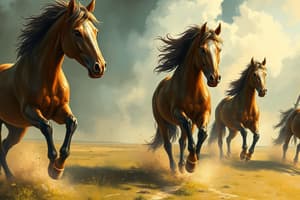Podcast
Questions and Answers
What does the use of 'subterfuge' suggest about how people cope with danger or violence?
What does the use of 'subterfuge' suggest about how people cope with danger or violence?
It suggests that people hide behind a false sense of security instead of confronting the reality of danger.
Explain the significance of the horse's action in the poem.
Explain the significance of the horse's action in the poem.
The horse’s stumbling symbolizes the fragility of peace and the lurking threat of violence.
What does atavism refer to in the context of the poem?
What does atavism refer to in the context of the poem?
Atavism refers to the reversion to ancestral traits and the connection to the historical suffering of the Irish.
How does Boland challenge readers in the final couplets of the poem?
How does Boland challenge readers in the final couplets of the poem?
Signup and view all the answers
What imagery does Boland use to evoke a sense of historical reflection?
What imagery does Boland use to evoke a sense of historical reflection?
Signup and view all the answers
Study Notes
Overview of 'The War Horse'
- Written by Eavan Boland in 1975 during a time of renewed troubles in Northern Ireland.
- The poem captures a horse passing by and damaging foliage, symbolizing deeper themes of violence and apathy.
Title Significance
- "The War Horse" evokes imagery of violence associated with battle.
- Reflects the powerful nature of horses used in warfare, introducing themes of destruction.
Main Themes
- Ordinary moments can provoke reflection on broader issues.
- Examines violence, particularly the apathy towards violence that doesn't directly affect one's life.
- Highlights the ravaging effects of war on people and nature.
Poetic Style
- Utilizes auditory and visual imagery to bring scenes to life.
- Enjambment mirrors the horse's movement, while caesura allows for pauses that invite reflection.
- Incorporates figurative language, notably personification and simile.
- The poem is structured entirely in couplets, consisting of 30 lines.
Analysis of Content
- The poem opens with an ordinary suburban scene, juxtaposing the calm setting with the title's violent implications.
- Initial sound of the horse is described in a casual manner, using alliteration to draw readers in.
- The vivid imagery of the horse "stamping" illustrates the impact of its presence on the earth.
Imagery and Movement
- Figure of the horse is described in detail, enhancing authenticity and creating a contrast between confinement (tethering) and freedom.
- Auditory elements, such as the horse's "hissing" and "snuffling," add depth to the visual description.
- The horse's quick passing reflects both a literal and metaphorical moment of conflict.
Reflections on Apathy
- The line "No great harm is done" juxtaposes the seemingly minor damage with the larger implications of conflict.
- Boland’s simile comparing a leaf to a "maimed limb" emphasizes societal desensitization to distant suffering.
Connection to War
- The transformation of ordinary images into war-related metaphors deepens the poem's impact.
- The reference to "screamless dead" highlights voiceless victims of violence, linking personal loss to broader conflicts.
Universal Themes
- The poem reveals how colonial histories affect present perceptions of safety and violence.
- Contrasts suburban safety with the terror experienced by others, provoking a moral reflection on complacency.
Conclusion
- The closing couplets compel readers to consider their roles in society and the importance of acknowledging violence beyond personal experience.
- Boland's reflections connect the past to contemporary issues, challenging apathy and encouraging engagement with societal conflicts.
Studying That Suits You
Use AI to generate personalized quizzes and flashcards to suit your learning preferences.
Description
'The War Horse' by Eavan Boland provides a poignant exploration of themes related to violence and apathy during a tumultuous period in Northern Ireland. This quiz delves into the poem's imagery, structure, and significant themes, encouraging reflection on how ordinary moments can reveal deeper societal issues. Analyzing the poetic style, including enjambment and figurative language, enhances our understanding of Boland's work.




